Connection of the motor winding:
There are several ways of connecting a three phase motor winding . The most common ones
3-phase connection are:
1)delta(∆)-connection
2)star (Y)-connection.
3-phase connection of induction motor winding
There are several ways of connecting a three phase motor winding . The most common ones
3-phase connection are:
1)delta(∆)-connection
2)star (Y)-connection.
3-phase connection of induction motor winding
According to the IEC 60034-8 standard, the windings of a 3-phase standard motor can be connected in either a star (Y)-connection or in a delta (∆)-connection.
Star (Y)-connection:
By short-circuiting the terminals W2, U2 and V2 and connecting the mains to W1, U1 and V1, you get a star (Y)-connection.
 |
| Fig:star connected 3 phase motor winding connection diagram |
 |
| fig:Fig: current in star connected motor winding |
Delta (∆)-connection:
When you connect the end of a phase to the start of another phase you get a delta (∆)-connection
i.e W2-U1, U2-V1, V2-W1 as shown in figure by connecting main supply to U1 V1 W1
 | |||||||||||||||
| Fig: delta connected 3 phase motor winding connection diagram |
 |
| Fig:delta connected motor winding current |















